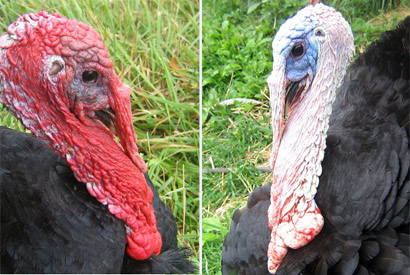We're open daily! View holiday hours
Science News
Turkey Sensors
January 22, 2014
by Molly Michelson

UC Berkeley researchers demonstrate that we can be thankful for turkeys all year round.
Did you know that turkeys change color depending on their mood? Well, turkey skin, it turns out, can shift from red to blue to white, thanks to bundles of collagen that are interspersed with a dense array of blood vessels. It is this color-shifting characteristic that gives turkeys the name “seven-faced birds” in Japanese and Korean.
Scientists discovered that spacing between the collagen fibers changes when the blood vessels swell or contract, depending upon whether the bird is excited or angry. The amount of swelling changes the way light waves are scattered and, in turn, alters the colors we see on the bird’s head.
The turkey color change inspired a team at Berkeley, led by Seung-Wuk Lee. Could a biosensor mimicking this natural occurrence change color when exposed to chemical vapors?
“In our lab, we study how light is generated and changes in nature, and then we use what we learn to engineer novel devices,” says Lee. Their latest novel device has potential to protect human health—and national security!
Many materials in nature change colors in response to stimuli, making them attractive for use as sensor platforms. However, both natural materials and their synthetic substitutes lack selectivity towards specific chemicals, and introducing such selectivity remains a challenge. Lee and his colleagues created a sensing material composed of filamentous bacterial viruses, which mimics the turkey skin process and rapidly swells, undergoing distinct color changes when exposed to volatile organic compounds.
The researchers then created a mobile app, the iColour Analyser. The app demonstrates how a smartphone photo could be used to analyze a sensor’s color bands to detect chemicals of interest, from various toxins and airborne pathogens to explosive TNT vapor.
“Our system is convenient, and it is cheap to make,” said Lee. “We also showed that this technology can be adapted so that smartphones can help analyze the color fingerprint of the target chemical. In the future, we could potentially use this same technology to create a breath test to detect cancer and other diseases.”
Thanks, turkeys!
The study is published this week in Nature Communications.
Image: Valerie Burtchett